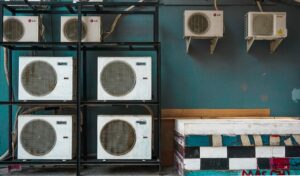The spin cycle is a crucial component of any washing machine. It is responsible for removing excess water from the clothes after they have been washed. Without a properly functioning spin cycle, your clothes would come out of the washing machine soaking wet, requiring additional time and effort to dry them. Understanding spin cycle issues is important because it allows you to diagnose and troubleshoot problems that may arise, ensuring that your washing machine continues to perform optimally.
Key Takeaways
- Understanding the basics of spin cycle in washing machines:
- Spin cycle is the final stage of a washing machine’s cycle where excess water is removed from clothes.
- The spin cycle is achieved through the rotation of the drum at high speeds.
- Common problems encountered during spin cycle:
- Clothes coming out still wet or dripping with water.
- Loud noises or vibrations during the spin cycle.
- The washing machine not spinning at all.
- Identifying the causes of spin cycle issues:
- Unbalanced loads or overloading the washing machine.
- Worn or damaged belts, bearings, or motor couplings.
- Clogged or damaged drain pump or hoses.
- How to diagnose spin cycle problems:
- Check for an unbalanced load or overloading.
- Inspect belts, bearings, motor couplings, drain pump, and hoses for damage or wear.
- Listen for unusual noises or vibrations during the spin cycle.
- Tips for troubleshooting spin cycle issues:
- Level the washing machine.
- Use the correct amount of detergent and avoid overloading.
- Clean the drain pump and hoses regularly.
- Fixing spin cycle problems: DIY vs. professional help:
- Simple issues like unbalanced loads or clogged hoses can be fixed by the owner.
- More complex issues like motor couplings or bearings may require professional help.
- Replacing faulty parts in spin cycle mechanism:
- Belts, bearings, motor couplings, and drain pumps can be replaced by the owner or a professional.
- It is important to use the correct replacement parts for the specific washing machine model.
- Preventing future spin cycle problems:
- Avoid overloading the washing machine.
- Regularly clean the drain pump and hoses.
- Level the washing machine.
- Maintaining your washing machine for optimal performance:
- Clean the washing machine drum and detergent dispenser regularly.
- Use the correct amount of detergent.
- Check and clean the filter regularly.
- When to consider replacing your washing machine:
- If the washing machine is more than 10 years old.
- If the cost of repairs is more than half the cost of a new washing machine.
- If the washing machine is not performing well despite repairs.
Understanding the Basics of Spin Cycle in Washing Machines
The spin cycle in a washing machine is the final stage of the wash cycle. Once the clothes have been washed and rinsed, the spin cycle begins. During this stage, the drum of the washing machine spins rapidly, using centrifugal force to extract water from the clothes. The water is then drained out of the machine, leaving the clothes damp but not dripping wet.
There are different types of spin cycles available in washing machines, including regular spin, delicate spin, and no spin options. The regular spin cycle is suitable for most types of clothing and is the default setting on most machines. The delicate spin cycle is designed for more delicate fabrics that require gentler handling. The no spin option allows you to skip the spin cycle altogether, which can be useful if you want to hand dry certain items or if you have a separate dryer.
Common Problems Encountered During Spin Cycle
There are several common problems that can occur during the spin cycle of a washing machine. These include excessive vibration, loud noises, failure to spin, and uneven spinning. Excessive vibration can be caused by an unbalanced load or an issue with the machine’s suspension system. Loud noises can indicate a problem with the motor or bearings. Failure to spin can be caused by a faulty motor or a problem with the belt or pulley system. Uneven spinning can be caused by an unbalanced load or an issue with the machine’s suspension system.
These spin cycle problems can have a significant impact on the performance of your washing machine. Excessive vibration can cause damage to the machine and surrounding structures, while loud noises can be disruptive and indicate underlying issues. Failure to spin or uneven spinning can result in clothes that are not properly cleaned or dried, requiring additional time and effort to rewash or dry them.
Identifying the Causes of Spin Cycle Issues
To effectively troubleshoot spin cycle problems, it is important to understand the underlying causes. Excessive vibration can be caused by an unbalanced load, which can be resolved by redistributing the clothes evenly in the drum. If the vibration persists, it may indicate a problem with the machine’s suspension system, such as worn-out shock absorbers or springs.
Loud noises during the spin cycle can be caused by a faulty motor or bearings. If you hear grinding or squealing noises, it may indicate that the motor or bearings need to be replaced. Failure to spin or uneven spinning can be caused by a faulty motor, belt, or pulley system. If the motor is not running, it may need to be replaced. If the belt is worn or broken, it will need to be replaced. If the pulley system is not functioning properly, it may need to be repaired or replaced.
How to Diagnose Spin Cycle Problems
Diagnosing spin cycle problems requires a systematic approach. Start by checking for any visible signs of damage or wear on the machine’s exterior and interior components. Inspect the drum for any loose items that may be causing an unbalanced load. Check the suspension system for any signs of damage or wear, such as broken springs or worn-out shock absorbers.
Next, test the motor by running the machine without any clothes in it. If the motor does not start or makes unusual noises, it may need to be replaced. Check the belt and pulley system for any signs of wear or damage. If the belt is worn or broken, it will need to be replaced. If the pulley system is not functioning properly, it may need to be repaired or replaced.
Tips for Troubleshooting Spin Cycle Issues

There are several troubleshooting tips that can help you resolve spin cycle problems without professional help. Start by redistributing the clothes evenly in the drum to ensure a balanced load. If the machine is still vibrating excessively, try adjusting the machine’s leveling feet to ensure that it is sitting level on the floor.
If you hear loud noises during the spin cycle, check for any loose items in the drum that may be causing the noise. If the noise persists, it may indicate a problem with the motor or bearings, which will require professional help to repair or replace.
If the machine fails to spin or spins unevenly, check the motor, belt, and pulley system for any signs of wear or damage. If any of these components are faulty, they will need to be repaired or replaced.
Fixing Spin Cycle Problems: DIY vs. Professional Help
When it comes to fixing spin cycle problems, there are pros and cons to both DIY and professional help. DIY repairs can save you money and give you a sense of accomplishment. However, they require time, effort, and technical knowledge. If you are not comfortable working with electrical components or if you are unsure about your ability to diagnose and fix the problem, it is best to seek professional help.
Professional repairs can be more expensive but offer the expertise and experience needed to quickly and effectively resolve spin cycle issues. They also come with warranties and guarantees, providing peace of mind that the problem will be fixed correctly.
Replacing Faulty Parts in Spin Cycle Mechanism
If you have identified a faulty part in the spin cycle mechanism, such as a motor, belt, or pulley, you will need to replace it. Start by disconnecting the power supply to the washing machine and removing the back panel to access the internal components. Follow the manufacturer’s instructions for removing and replacing the faulty part.
When replacing a motor, belt, or pulley, it is important to use the correct replacement part. Consult the washing machine’s manual or contact the manufacturer for guidance. Once the new part is installed, reassemble the machine and test it to ensure that the spin cycle is functioning properly.
Preventing Future Spin Cycle Problems
Preventing spin cycle problems starts with proper maintenance and care of your washing machine. Avoid overloading the machine, as this can cause excessive vibration and strain on the motor and other components. Distribute the clothes evenly in the drum to ensure a balanced load.
Regularly clean the drum and filter to remove any debris or lint that may accumulate over time. This will help prevent clogs and ensure optimal performance. Avoid using too much detergent, as this can cause excessive suds that can interfere with the spin cycle.
Maintaining Your Washing Machine for Optimal Performance
Regular maintenance is essential for keeping your washing machine in optimal condition. Clean the drum and filter regularly to remove any debris or lint. Check the hoses for any signs of wear or damage and replace them if necessary. Inspect the motor, belt, and pulley system for any signs of wear or damage and replace them as needed.
In addition to regular cleaning and inspection, it is important to follow the manufacturer’s guidelines for maintenance. This may include periodic lubrication of moving parts, such as bearings or pulleys, or cleaning of specific components.
When to Consider Replacing Your Washing Machine
There are several signs that indicate it may be time to replace your washing machine. If you are experiencing frequent spin cycle problems that cannot be easily resolved or if the cost of repairs exceeds the value of the machine, it may be more cost-effective to invest in a new machine.
Other signs that it may be time to replace your washing machine include excessive noise, leaks, or a significant decrease in performance. If your machine is more than 10 years old, it may also be worth considering a replacement, as newer models are often more energy-efficient and offer advanced features.
The spin cycle is a crucial component of any washing machine, and understanding and troubleshooting spin cycle issues is important for maintaining optimal performance. By identifying the causes of spin cycle problems and following a systematic approach to diagnosis and troubleshooting, you can resolve many issues on your own. However, there are times when professional help may be necessary or when it may be more cost-effective to replace the machine altogether. Regular maintenance and care of your washing machine can help prevent future spin cycle problems and ensure that your machine continues to perform optimally.
If you’re struggling with spin cycle problems in your washing machine, you’ll definitely want to check out this informative article on diagnosing and fixing these issues. It provides valuable insights and practical tips to help you troubleshoot and resolve common spin cycle problems. Whether your washing machine is making strange noises, not spinning at all, or leaving clothes soaking wet, this article has got you covered. Don’t let spin cycle struggles ruin your laundry routine – click here to read the article and get your washing machine back in top shape.
What Are Common Issues That Cause Irregular Spinning in the Spin Cycle?
There are several troubleshooting irregular spinning issues that can cause problems during the spin cycle of a washing machine. Some of the common issues include unbalanced loads, a malfunctioning lid switch, or a worn-out drive belt. It is important to address these issues promptly to avoid further damage to the appliance.



